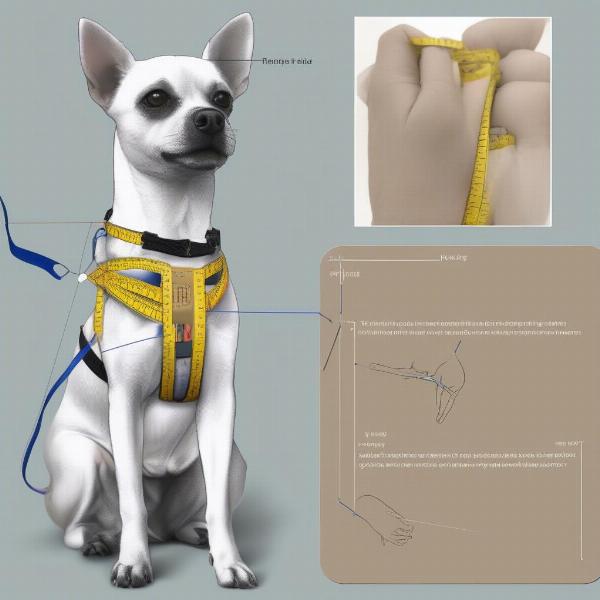A small dog harness vest is more than just a fashionable accessory; it’s a crucial piece of equipment for ensuring your petite pup’s safety and comfort during walks and adventures. Whether you’re navigating bustling city streets or exploring tranquil nature trails, a well-fitted harness vest provides better control, reduces strain on your dog’s delicate neck, and can even prevent escape artist antics. This guide will delve into the world of small dog harness vests, helping you select the ideal option for your furry friend.
Choosing the right harness can feel overwhelming with so many options available. From different materials and designs to varying sizes and functionalities, it’s essential to consider your dog’s specific needs and lifestyle. This article will cover everything you need to know about finding the perfect small dog harness vest, ensuring your tiny companion stays safe, comfortable, and stylish.
Types of Small Dog Harness Vests
Understanding the various types of harnesses is the first step in making an informed decision. Each type offers unique benefits and is suited to different needs.
Step-in Harnesses
These harnesses are easy to put on, simply requiring your dog to step into the leg holes. They are often a good choice for puppies or dogs who dislike having things pulled over their heads.
Over-the-Head Harnesses
These harnesses slip over your dog’s head and are secured with buckles or clips. They tend to be more secure than step-in harnesses and offer greater control, especially for dogs who pull on the leash.
No-Pull Harnesses
Designed to discourage pulling, these harnesses often have a front-clip leash attachment point that redirects the dog’s forward momentum when they pull. This can be a valuable training tool for excitable small breeds.
Sizing and Fitting Your Small Dog Harness Vest
A properly fitted harness is essential for both comfort and effectiveness. A harness that’s too loose can allow your dog to escape, while a harness that’s too tight can restrict movement and cause discomfort.
- Measure accurately: Use a flexible measuring tape to determine your dog’s girth (around the chest, behind the front legs) and neck circumference.
- Consult size charts: Refer to the manufacturer’s size chart for the specific harness you’re considering. Don’t rely solely on weight recommendations.
- The two-finger rule: You should be able to comfortably fit two fingers between the harness and your dog’s body.
 Measuring a Small Dog for a Harness
Measuring a Small Dog for a Harness
Material and Durability
Consider the material and durability of the harness, especially if your dog is particularly active.
- Nylon: A durable and easy-to-clean option.
- Leather: A stylish and strong choice, but requires more care.
- Mesh: Breathable and lightweight, ideal for hot weather.
- Reflective materials: Enhance visibility during low-light conditions.
“A quality harness should be robust enough to withstand daily wear and tear, especially for adventurous small dogs,” advises Dr. Emily Carter, DVM, a certified veterinary behaviorist.
Key Features to Consider
Beyond the basics, several features can enhance the functionality and comfort of your small dog harness vest. Padding, adjustable straps, and multiple leash attachment points can make a significant difference.
Safety and Visibility
Opt for harnesses with reflective strips or bright colors to ensure your dog is easily visible, especially during nighttime walks. A sturdy D-ring leash attachment point is crucial for secure walks.
Comfort and Adjustability
Look for harnesses with padded straps and adjustable buckles to provide a comfortable and customized fit for your small dog.
Conclusion
Choosing the perfect small dog harness vest requires careful consideration of your dog’s individual needs, lifestyle, and personality. By understanding the different types of harnesses available, taking accurate measurements, and prioritizing features like comfort, durability, and safety, you can ensure your small companion enjoys safe and comfortable walks for years to come. Remember, a well-fitted harness is an investment in your dog’s well-being and your peace of mind.
FAQ
- What type of harness is best for a small dog that pulls? A no-pull harness with a front-clip leash attachment is often effective for discouraging pulling.
- How do I know if my dog’s harness fits correctly? You should be able to comfortably fit two fingers between the harness and your dog’s body.
- What material is best for a small dog harness? Nylon is a durable and easy-to-clean option, while mesh is breathable for hot weather.
- Are there harnesses specifically designed for small breeds? Yes, many manufacturers offer harnesses designed specifically for the unique proportions of small breeds.
- What is the importance of a D-ring leash attachment? A sturdy D-ring provides a secure attachment point for the leash, preventing escapes.
- Can I use a harness for training my small dog? Yes, harnesses can be used in conjunction with positive reinforcement training methods.
- How often should I clean my dog’s harness? Regular cleaning is essential. Follow the manufacturer’s instructions for cleaning recommendations.
About ILM Dog
ILM Dog is your trusted resource for expert advice on all aspects of dog care and well-being. From breed selection and puppy care to senior dog care and product recommendations, we provide practical, reliable information to help you nurture your canine companion. Our expertise encompasses dog health, nutrition, training, grooming, and much more. Contact us today for tailored advice and support on your dog ownership journey: Email: [email protected], Phone: +44 20-3965-8624.